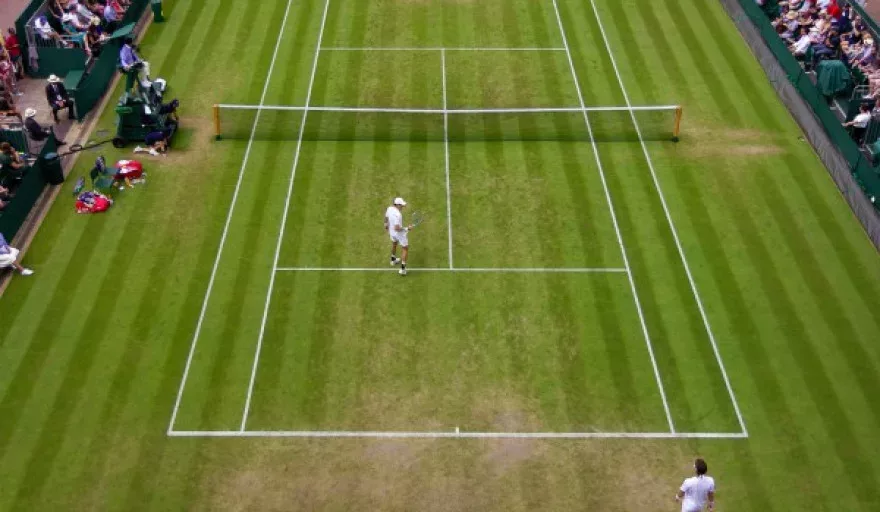Be it the development of AI-centric highlights or improvements in technologically driven training techniques, the partnership of IBM and Wimbledon has brought countless benefits for fans, players and the media alike.
INTRODUCTION
Wimbledon is best described as a special affair.
The tennis grand slam has entrenched itself as one of the most prestigious sporting events of the calendar year, renowned as beautifully British and eclectically eccentric, yet perfectly balanced with innovation and modernisation.
Settling into the north-westerly facing stand of Court 3 on Manic Monday, it was easy to see how this equilibrium between The Championship’s habitual heritage and avant-garde technologies had come to fruition.
As the third march of the day began, crowd-wide mutters of admiration quickly spread after 141 miles per hour was displayed on one of the subtly placed courtside serve speed trackers following a trademark opening from 15th seed Milos Raonic.
This pattern continued during the first two sets while numerous challenges on pinpoint aces from opponent, and eventual victor, Guido Pella showcased the best of Hawkeye that ourselves and 2,000 other spectators took great satisfaction from, despite immaculate displays from the uniform-clad line judges’ in what turned out to be an enticing, marathon five-set match.
Swept up in the atmosphere, it was easy to take even these most prominent and familiar technologies for granted, let alone those that have been helping to revolutionise the sport from behind the scenes.
While artificial intelligence has become a flagship for the tournament in recent years, evident in the latest string of bias detection advancements that Tom has been referring to, there are others that have equally come to the fore.
TRANSFORMING TENNIS
“Wimbledon is increasingly becoming a data-driven media organisation,” explained Simon Boyden as we entered the Bunker.
Pointing to data as another key driver of next-generation content, the Digital Architect was quick to highlight its role in enabling the delivery of increasingly informative insights when coupled with cloud technologies.
“We collect around 4.8 million data points in an average championship,” he continues, “working with professional tennis players in doing so, teaching them how to use our technologies and positioning them across the courts to compile the details of every point in every match.
“We select sportspeople over technical professionals due to their ability to not only understand the rules of the game but equally the flow. They recognise exactly what has happened, such as the difference between a forced or unforced error, and are able to record that, ensuring we maintain maximum accuracy.”
With between one and three statisticians located on each of the 18 courts, every game is tracked in this way. On Centre Court and Court One, for example, one data entry person calls the game, another monitors the speed and direction of serves and a third inputs the information into a database.
Meanwhile data scientists are also located in IBM’s Bunker with access to live video of all concurrent matches, instant replays and more, providing assistance to iron out discrepancies or indeterminate details.
“We’re really focused on getting 100 percent accuracy and sub-second response time,” Boyden adds.
EMBRACING ENGAGEMENT
Collected and collated, this validated point-by-point database has several competitive advantages, be it providing new fan experiences or optimising IT operations.
“This information portfolio is partially used to create key television graphics,” Boyden reveals, highlighting the media application as a key necessity behind the rapid response times. “Again, the same 48 employees are given responsibility to recommend interesting statistics to use in on-screen pop ups based on the way any given match may be headed.
“The graphics may constitute anything from first service percentages versus second service percentages to the total number of points won by a particular player – they are entirely motivated by an understanding of the game and facilitated by new technologies and the data available.”
On-screen graphics are not the only way in which this data is consumed, however.
Equally, when the likes of John McEnroe or Boris Becker are commentating, or indeed Sue Barker or Claire Balding are presenting coverage, many of the key insights that they highlight are discovered using the Wimbledon Information System.
“When arcane statistics are pulled up, they generally come from this space,” Boyden affirms. “Our cloud platform does a variety of things, providing a huge range of statistics about players, specific matches and even historical information, with our database stretching back to the 1870s.”
Players too have been the benefactors of this ever-improving data portfolio.
Boyden continues, eluding to the player portal as a third and final spearhead: “We upload videos here and offer access to the point trail information of any match that is compiled by our 48 tennis pros turned IBM experts.
“It makes for a great training aid, allowing any competitor to look at both their own game and a potential opponent’s game, identifying strengths and weaknesses on both sides and facilitating the development of tailored tactics and game plans.”
Owed to these ground-breaking, revolutionary strides, technological innovation has become not only what fans want from tennis and sport in general, but what they expect.
Be it the development of AI-centric highlights or improvements in technologically driven training techniques, IBM’s partnership with Wimbledon has brought countless benefits thick and fast for fans, players and the media alike over the past three decades.
Looking beyond the 2019 Championships, as this collaboration moves past its 30th birthday and into a new chapter, it is one that will more than likely continue to bear fruit in unlocking insights and inspiring content for years to come.



















